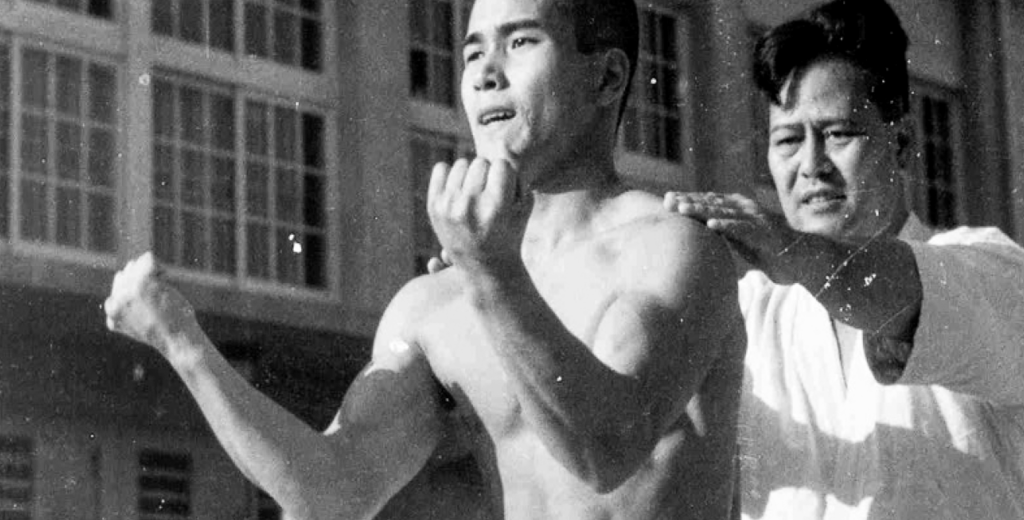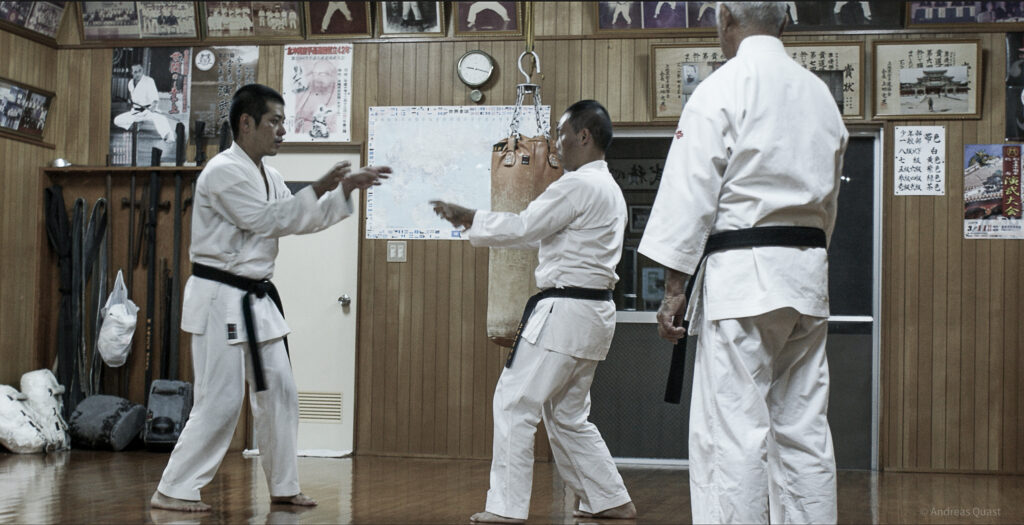I met Tōme San in 2012 at a larger martial arts demonstration meet held at the Prefectural Budōkan in Naha. I had met him before at the dōjō of Senaga Yoshitsune Sensei of Uechi-ryū. At the time of the martial arts demonstration at the Budōkan, his kids were part of the Matsubayashi-ryū group, so I asked him why his kids train Matsubayashi-ryū instead of Uechi-ryū, and he replied “Uechi-ryū is too hard for kids.” A similar train of thought existed long before and was described by Kinjō Hiroshi in his last book in a chapter entitled “The Study of Shuri-te for School Education.”
According to Kinjō, Itosu Ankō, along with Higaonna Kanryō and members of the Prefectural Middle School, conducted research in accordance with the instructions given by the School Affairs Division. The results of this research were reported back to the School Affairs Division on several occasions, and the School Affairs Division appears to have commented on it every time and requested corrections. One such correction relates to Sanchin of today’s Gōjū-ryū.
This Sanchin seems to have also been considered as a kata meant for karate in school education. However, Sanchin seems to have received criticism from the School Affairs Division. While the exact appearance of Higaonna Kanryō’s Sanchin is unknown today, the School Affairs Division probably insisted on removing Sanchin from the kata list due to its violent compression of the lungs, chest and organs while inhaling and exhaling, and probably the violent tension in the lower body (hips, knees, ankles) and how that would affect health and growth during childhood.
Kinjō heard this explanation directly from his cousin Tamaki Yūzen (1890–1925), who was enrolled in the Prefectural Middle School for six years starting in 1903. Tamaki Yūzen also mentioned that he received instruction from Itosu Ankō at the Prefectural Middle School since prior to the time when karate became a compulsory subject in 1905.
As a result of the course of the above-described research, a final list of kata for school education was decided upon. The kata are presented in the list below. This kata list was not fixed and written down in an actual record but was created by Kinjō Hiroshi based on suggestions made by Tokuda Antei, who attended Okinawa Prefectural Middle School for five years from 1905 to 1910, followed by two years at the normal school. During these seven years, Kinjō says that Tokuda was instructed by Itosu Ankō, and therefore, Tokuda was a witness to this framework of kata used in school karate. For details on Tokuda Antei’s written heritage, see my 2017 article “Tokuda Antei’s Memorandum.”
Here follows the list of 14 kata of Shuri-te as created by Kinjō Hiroshi.
Framework of 14 Kata
Kata modified from Suidī
- 1. Kūsankū (Dai)
- 2. Kūsankū (Shō)
- 3. Passai (Dai)
- 4. Passai (Shō)
- 5. Chintō
- 6. Gojūshiho
- 7. Naifanchi Shodan
Newly created kata
- 1. Naifanchi Nidan
- 2. Naifanchi Sandan
- 3. Pinan Shodan
- 4. Pinan Nidan
- 5. Pinan Sandan
- 6. Pinan Yondan
- 7. Pinan Godan
There are several points to consider. Most importantly, and while using the same characters, to distinguish between old-style and school education, Kinjō referred to the old-style kata as Suidī, and for kata modified by Itosu for school education as Shuri-te. This is to say, even though this differentiation didn’t exist at the time, the conceptional and technical differences between the two were retrospectively distinguished by a specific terminology, namely Suidī versus Shuri-te. As a working theory, and for reasons of clear communication, this is a useful solution.
As regards Sanchin, Tokuda mentioned as follows:
When I attended Middle School, karate, jūdō, sumō and the like were begun to be put into practice. Karate started with both Hanashiro Sensei and Yabu Sensei and about twenty students and interested persons. Practice such as the foundational Naihanchi took place on the premises of the Okinawa Bank at the site of the former National Academy in Shuri Tōnokura. Occasionally we went to the house of venerable old Higaonna [Kanryō] in Naha and practiced Sanchin, and later welcomed venerable old Itosu at school and received instruction.
Around the same time, at the 1909 martial arts demonstration meet of the Dai Nippon Butokukai in Kyōto, three students from the Shuri middle school performed Kūsankū Shō and Dai as well as Sanchin. However, due to educational caveats by the School Affairs Division, Sanchin did not become a part of karate used in school education.
It can be said that karate used in school education around that time is the core element of what is now called Shuri-te. As a distinction, their old-style predecessors can be called Suidī but it is unclear if they were in fact handed down. Today, the term Suidī is used variously, sometimes simply to use an Okinawan word instead of standard Japanese, sometimes to insinuate that it is actually the old-style versions of kata from the 19th century. So far, however, no one seems to have provided proof of an ancient tradition, except of the fact that occasionally extra kata were learned from teachers outside of Itosu’s school karate system. Often more recent ideas of grappling and various combat methods are simply applied to those old names, when in fact these seem to be reinterpretations – such grapplifications or jujutsufications – of what is actually Shuri-te in above definition. While lineages exist, there don’t seem to exist an actual personal tradition of combative applications handed down over several generations. Anyone can create an application ad hoc and it is the greatness of kata as a conception that lies in its undefined nature that allows for such infinite interpretation of moves, methods, applications, and tactics at any time.
In this context, one may also wonder if the change from open hands to fists in Sanchin as well as other possible modifications were Higaonna’s concessions towards the School Affairs Division which were then continued to be taught, even though the kata didn’t make it into school karate at the time.
Later, in the 1930s and early 1940s, with shifts in what authorities considered desirable and preferable in training the young men’s “national bodies,” Sanchin seems to have regained popularity as a form of “training of the spirit” or a “kata for forging mind and body” (tanren kata) rather than a directly applicable, mere technical skill, and this conception seems to have been continued almost unchanged since the immediate postwar era.
© 2024, Andreas Quast. All rights reserved.


